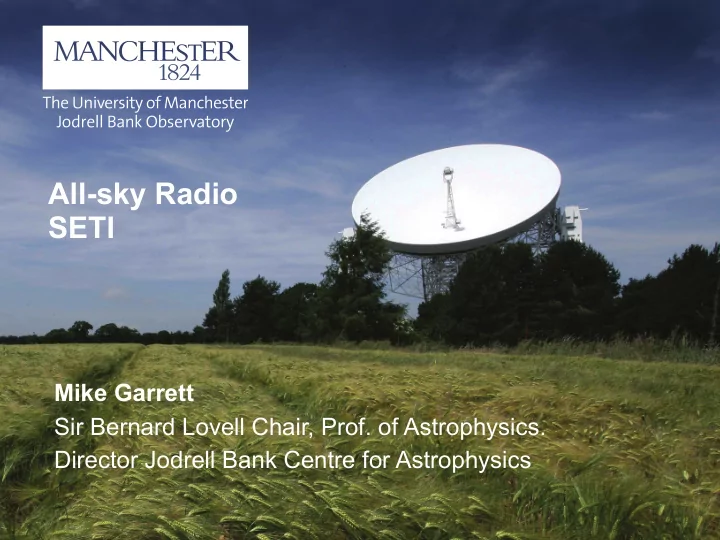

The Search for Extraterrestrial Intelligence (SETI) All-sky Radio SETI Mike Garrett Sir Bernard Lovell Chair, Prof. of Astrophysics. Director Jodrell Bank Centre for Astrophysics Mike Garrett Sir Bernard Lovell Chair, Prof. of Astrophysics. Director Jodrell Bank Centre for Astrophysics
• Is SETI a sensible scientific pursuit? • Are there any signals out there to detect ? • Why SETI might be really difficult … • How can we do better in the radio ?
• Is SETI a sensible scientific pursuit?
P R A P R = P T A 2 P T P T D 2 λ 2 A Friis transmission formula e.g. 10 MWatt transmitter located at the nearest star, P R ~ 5x10 -19 Watt. => Detectable by Lovell Telescope with a SNR ~ 1000 in 1 sec.
P R A P R = P T A 2 P T P T D 2 λ 2 A Friis transmission formula e.g. 10 MWatt transmitter located at the nearest star, P R ~ 5x10 -19 Watt. => Detectable by Lovell Telescope with a SNR ~ 1000 in 1 sec.
• Is SETI a sensible scientific pursuit? ‣ yes its plausible - our telescopes are sensitive enough to detect powerful radio transmissions from other (nearby) civilisations in the Milky Way.
Breakthrough Listen GBT Parkes Milner, Worden, Siemion et al. 2016 Parkes GBT
• Is SETI a sensible scientific pursuit? ‣ Are there signals out there to detect or are we alone ?
• The evidence suggests success in SETI is going to be difficult … ‣ So far no obvious SETI signals have been detected. ‣ Astronomical data in general show no signatures (so far) of advanced civilisations. ‣ Solar system is pristine with no evidence of visitations from advanced civilisations. ‣ Intelligent life took a long time to arise on this planet, and may be universally “rare”. ‣ Milky Way is big, old and the speed of light is finite. ‣ From “our experience of one" technical (radio phase) civilisations may have v. short lifetimes …
SETI signals may be v. rare… What can we do to make it easier for ourselves ?
Fast Radio Bursts (FRBs) as an example? FRBs are bright millisecond flashes of broadband radio emission randomly distributed on the sky… 2ms D. Futselaar
Fast Radio Burst Properties Duration: ~ few milliseconds => small size Peak Flux Density: > 0.5 Jy Signal highly dispersed: => extragalactic? Scattered => dense environments? Most events singular? Randomly located across sky No counterparts at other wavelengths Inferred event rates: 1000 x GBR rate. What are they? - Coalescing neutron stars/white dwarfs? - - Evaporating black holes? Planetary debris around NS? D. Futselaar - Plasma turbulence excited by a relativistic jet - Magnetar flares, SNe, Cosmic strings… ET?
FRBs now definitively known to be extragalactic… z=0.19 ChaXerjee et al. 2017, Tendulkar et al. 2017. Marcote et al. 2017
Somewhere between 5000-10000 FRBs events per day… ! Image of Mk2 detection of a burst We still don’t know what FRBs are… and we typically detect almost none of them (or about 1 in 100000! )
It’s all about Field-of-View (FoV)… Event Rate ~ FoV . S o-3/2+δ (δ often > 0.5 favouring FoV over sensitivity) If FRB pulses are distributed uniformly through the Universe without significant luminosity evolution, then the rate of FRBs detectable above a where b > 0 is known - J.P. Macquart (2013) as the source count index where b > 0 is known as the source count index
No coincidence that even the few FRBs we have detected, had to wait for the development of multi-beam receivers…
Plans to increasing Lovell Telescope Field of View by x10.
Temporal Resolution SETI Frequency Success! Resolution Frequency Coverage (Bandwidth)
Temporal Resolution SETI Frequency Sensitivity Success! Resolution Frequency Coverage (Bandwidth)
Temporal Resolution SETI Frequency Sensitivity Success! Resolution Frequency Spatial Coverage Resolution (Bandwidth)
Temporal Field of View Resolution SETI Frequency Sensitivity Success! Resolution Frequency Spatial Coverage Resolution (Bandwidth)
? Data Analysis & Signal recognition Temporal Field of View Resolution SETI Frequency Sensitivity Success! Resolution Frequency Spatial Coverage Resolution (Bandwidth)
First “all-sky” radio telescope concept - Argus - is well-described in “Imperial Earth” “Argus - multiple-eyed god, who could look in every direction simultaneously. Unlike poor Cyclops, who had only a single line of vision”.
“Thousands of elements - little more than stiff wires” - Arthur. C.Clarke.
“Switching and phasing that would allow Argus to swing its antennas electrically - without moving them physically“ - A.C.C.
-6
-6
All-sky Radio SETI SKA2-AA at cm-wavelengths
MFAA environmental tests MFAA environmental tests -6 Courtesy: P. Benthem (ASTRON)
Conclusions SETI is difficult… We’ve made enormous progress in many areas of SETI search space, except one - Field-of-View. Radio transient research (e.g. detection of FRBs) may point the way towards SETI success. Investment in Mid-Frequency (cm-wavelength) Aperture Array technology is required… now!
Are we just too stupid to see what is under our noses ? It looks us 2 million years to discover the most prevalent life form on this planet - simple bacteria and the microscopic life, how much longer will it take us to discover life other planets. Antoni van Leeuwenhoek
www.facebook.com/JodrellBankObservatory @JodrellBankObservatory Thank you!
Recommend
More recommend